James Parr
A Foundation Model for the Solar Dynamics Observatory
Oct 03, 2024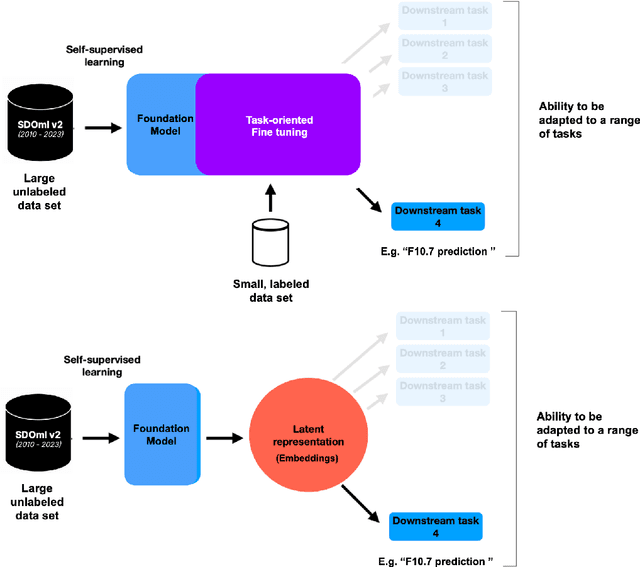

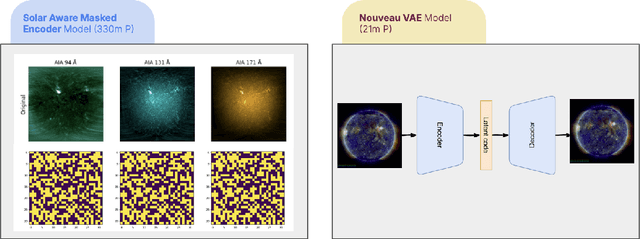
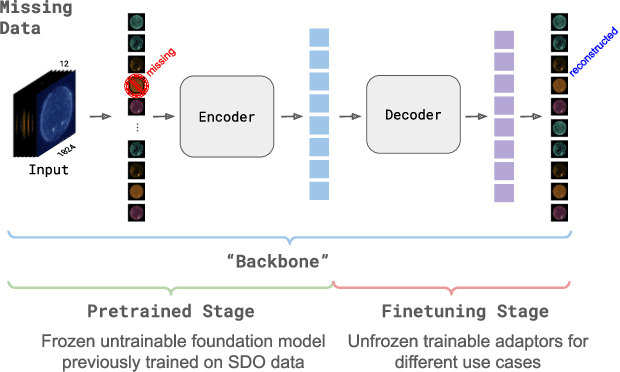
Abstract:SDO-FM is a foundation model using data from NASA's Solar Dynamics Observatory (SDO) spacecraft; integrating three separate instruments to encapsulate the Sun's complex physical interactions into a multi-modal embedding space. This model can be used to streamline scientific investigations involving SDO by making the enormous datasets more computationally accessible for heliophysics research and enable investigations that require instrument fusion. We discuss four key components: an ingestion pipeline to create machine learning ready datasets, the model architecture and training approach, resultant embeddings and fine-tunable models, and finally downstream fine-tuned applications. A key component of this effort has been to include subject matter specialists at each stage of development; reviewing the scientific value and providing guidance for model architecture, dataset, and training paradigm decisions. This paper marks release of our pretrained models and embedding datasets, available to the community on Hugging Face and sdofm.org.
Technology Readiness Levels for Machine Learning Systems
Jan 11, 2021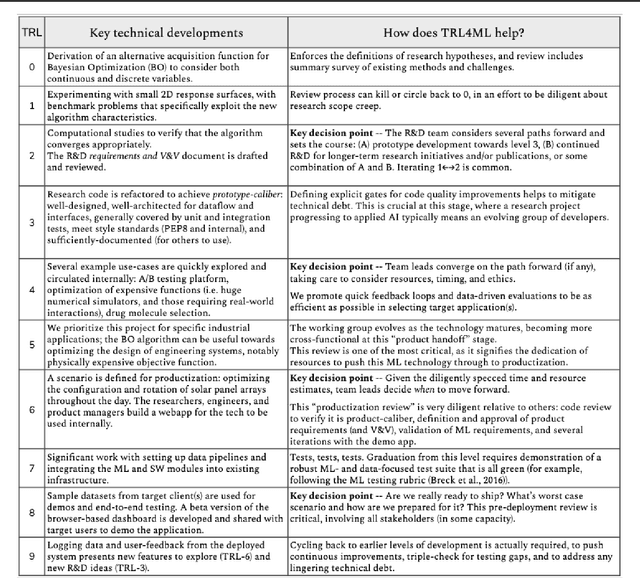
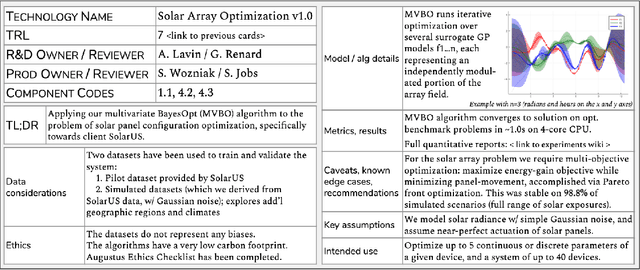
Abstract:The development and deployment of machine learning (ML) systems can be executed easily with modern tools, but the process is typically rushed and means-to-an-end. The lack of diligence can lead to technical debt, scope creep and misaligned objectives, model misuse and failures, and expensive consequences. Engineering systems, on the other hand, follow well-defined processes and testing standards to streamline development for high-quality, reliable results. The extreme is spacecraft systems, where mission critical measures and robustness are ingrained in the development process. Drawing on experience in both spacecraft engineering and ML (from research through product across domain areas), we have developed a proven systems engineering approach for machine learning development and deployment. Our "Machine Learning Technology Readiness Levels" (MLTRL) framework defines a principled process to ensure robust, reliable, and responsible systems while being streamlined for ML workflows, including key distinctions from traditional software engineering. Even more, MLTRL defines a lingua franca for people across teams and organizations to work collaboratively on artificial intelligence and machine learning technologies. Here we describe the framework and elucidate it with several real world use-cases of developing ML methods from basic research through productization and deployment, in areas such as medical diagnostics, consumer computer vision, satellite imagery, and particle physics.
Space ML: Distributed Open-source Research with Citizen Scientists for the Advancement of Space Technology for NASA
Dec 27, 2020Abstract:Traditionally, academic labs conduct open-ended research with the primary focus on discoveries with long-term value, rather than direct products that can be deployed in the real world. On the other hand, research in the industry is driven by its expected commercial return on investment, and hence focuses on a real world product with short-term timelines. In both cases, opportunity is selective, often available to researchers with advanced educational backgrounds. Research often happens behind closed doors and may be kept confidential until either its publication or product release, exacerbating the problem of AI reproducibility and slowing down future research by others in the field. As many research organizations tend to exclusively focus on specific areas, opportunities for interdisciplinary research reduce. Undertaking long-term bold research in unexplored fields with non-commercial yet great public value is hard due to factors including the high upfront risk, budgetary constraints, and a lack of availability of data and experts in niche fields. Only a few companies or well-funded research labs can afford to do such long-term research. With research organizations focused on an exploding array of fields and resources spread thin, opportunities for the maturation of interdisciplinary research reduce. Apart from these exigencies, there is also a need to engage citizen scientists through open-source contributors to play an active part in the research dialogue. We present a short case study of Space ML, an extension of the Frontier Development Lab, an AI accelerator for NASA. Space ML distributes open-source research and invites volunteer citizen scientists to partake in development and deployment of high social value products at the intersection of space and AI.
Learnings from Frontier Development Lab and SpaceML -- AI Accelerators for NASA and ESA
Nov 09, 2020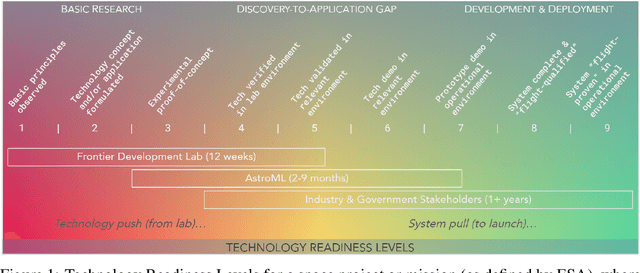

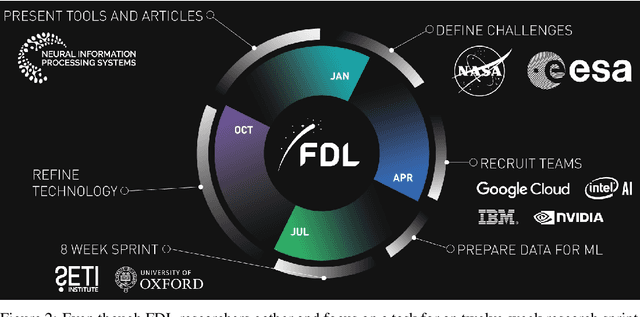
Abstract:Research with AI and ML technologies lives in a variety of settings with often asynchronous goals and timelines: academic labs and government organizations pursue open-ended research focusing on discoveries with long-term value, while research in industry is driven by commercial pursuits and hence focuses on short-term timelines and return on investment. The journey from research to product is often tacit or ad hoc, resulting in technology transition failures, further exacerbated when research and development is interorganizational and interdisciplinary. Even more, much of the ability to produce results remains locked in the private repositories and know-how of the individual researcher, slowing the impact on future research by others and contributing to the ML community's challenges in reproducibility. With research organizations focused on an exploding array of fields, opportunities for the handover and maturation of interdisciplinary research reduce. With these tensions, we see an emerging need to measure the correctness, impact, and relevance of research during its development to enable better collaboration, improved reproducibility, faster progress, and more trusted outcomes. We perform a case study of the Frontier Development Lab (FDL), an AI accelerator under a public-private partnership from NASA and ESA. FDL research follows principled practices that are grounded in responsible development, conduct, and dissemination of AI research, enabling FDL to churn successful interdisciplinary and interorganizational research projects, measured through NASA's Technology Readiness Levels. We also take a look at the SpaceML Open Source Research Program, which helps accelerate and transition FDL's research to deployable projects with wide spread adoption amongst citizen scientists.
 Add to Chrome
Add to Chrome Add to Firefox
Add to Firefox Add to Edge
Add to Edge